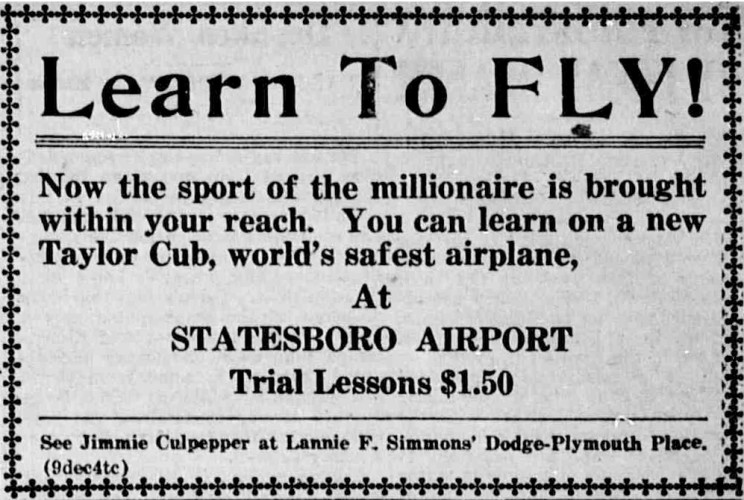
“A Brief History of the Statesboro Airport”
Dr. Brent Tharp, Georgia Southern University Museum
In 1934, the Statesboro Chamber of Commerce and others began to push for the development of a formal airport to be built in Bulloch County. For years, fliers had been using a field site known as the Alex Waters property as a landing strip. In the end, it was the Works Progress Administration (WPA) that made the dream possible. In 1936, the WPA completed an airport covering 93 acres on part of the M. M. Holland estate with a 4,000 foot grass landing strip for $10,000. In December of 1936, the county celebrated the arrival of the largest plane to have landed in the county, a Ford Tri-Motor. Sam Franklin, the Statesboro Distributor of Pure Oil Products sponsored the flight. For $1, adventurous Bulloch Countians could purchase a ride and see their home from a new perspective, a birds-eye view.
In its first 5 years, the airport served as a community gathering place for festivals, picnics, and carnivals and the local newspaper noted that Statesboro men “were growing air-minded.” Jimmie Culpepper began giving flying lessons in 1937. The first to complete them was Dr. John Mooney. The paper followed his first solo flight and reported that he made a perfect take-off and landing, with graceful turns and climbs. Other early pilots and enthusiasts were Charlie Oliff, Lannie Simmons, Claude Howard, Hoke Brunson, C. P. Oliff, and Doy Gay. They learned to fly in a Taylor Cub, the forefather of the very popular Piper Cub.
In November of 1939 the Junior Chamber of Commerce sponsored a carnival at the airport, which included performances by the Southern Aces Air and Ground Show with the main event being Jimmie Goodwin, “The Man From Mars,” world-famous bat wing artist. Goodwin would leap from a plane 10,000 feet in the air and soar to earth using his special bat wing suit. This would be the last festival on the grounds of the airport for many years. In 1940, as the country prepared its defenses in light of the gruesome war in Europe, the government began looking at the many airfields dotted across the country as potentially important military facilities.
On July 17, 1941, Bulloch County received news that its airport had been chosen for improvement as a defense landing field that would include two 4,000-ft. hard-surfaced runways, taxiways, a fence, and airfield lighting on the condition that the City and County procure a total of 604 acres. The city increased business license taxes by 100% for two years to pay for their portion of the project. To recoup some of their costs, the city sold the buildings on the newly acquired property including the dwelling of Mrs. Bertha Waters. The sale took place just 3 days after the attack on Pearl Harbor. Soon the project expanded as the U.S. Army Air Force enlarged the project acquiring an additional 285 acres to include an additional runway and property on the west side of the Dover Road (US 301) for barracks and facilities to house 180 officers and 400 men.
For most of the war, the Statesboro airport was a sub-base of Morris Field in Charlotte, NC. From March 1943 to October 1944, Statesboro hosted the 118th and the 23rd Reconnaissance Squadrons flying P-39 Aircobras and P-40 Warhawks and the 127th, 156th , 14th , 157th , 159th ,160th and the 161st Liason Units and the 3rd Air Commando Group flying the Stinson L-5 Sentinel and UC-64 Norseman.
Throughout WWII, liason aircraft served in a variety of roles including artillery observation, reconnaissance, aerial photography, medical evacuation, search and rescue, primary flight training, pilot proficiency, supply, and mail runs. Their pilots, many trained at Statesboro, were heroic individuals often asked to fly these unarmed aircraft over the front lines well within range of enemy guns.
In December of 1943, the Army Airfield hosted a crowd of thousands of area residents who came out for an air show including parades, music, speeches, and stunt flying for the “stimulation of interest in WAC recruiting” and in February 1944 Statesboro was “Bombed” with an air show promoting the 4th War Loan to help Bulloch County with her quota.
With the end of the war, the field and its infrastructure was turned back over to Statesboro and Bulloch County as a municipal airport. It was now an ordinary amenity in the lives of Bulloch Countians with nothing remarkable save the annual arrival of Santa Claus’ helpers, a tradition of the 1950s. Santa’s helpers would arrive by airplane, fly over the city before landing at the airport. From there, motorcycle police escorted them into the city.
The military returned to the Statesboro Airport in 1961 this time under the auspices of the Strategic Air Command. During the Vietnam War, teams that trained in Statesboro and other fields became critical to the war in Vietnam through their work with a project known as Combat Skyspot. In the early days of the Vietnam War, U.S. forces were unable to deliver ordnance with reasonable accuracy under conditions other than good weather and daylight. The best aircraft capable of all-weather day or night bombing was the B-52, but early missions using the aircraft’s on board bomb navigation system were not impressive. The military learned that they could reverse engineer a system they had been using to electronically score and test the bombing skills of SAC aircrews to accurately target bombs using radar installations on the ground. Ground directed bombing reduced error considerably. Units of the 1st Combat Evaluation Group trained using B-52s flying out of Eglin AFB regularly “bombing” Statesboro. Combat Skyspot was used in every major campaign beginning in 1966, in Laos, Cambodia, South Vietnam, and North Vietnam, except for operations too far north to allow radar tracking.
